

 |
| Lab Alumni: Ph.D.'s Masters Postdocs Undergraduates |
Ph.D.'s |
|
 |
Keith Bouma-Gregson, Ph.D. 2017 |
 |
Eric Armstrong, Ph.D. 2017 Co-advised with Dr. Jonathan Stillman |
 |
Jack Sculley, Ph.D. 2013 |
 |
Charlene Ng, Ph.D. 2012 |
|
Mike Limm, Ph.D. 2010 My primary interest is understanding how the physical characteristics of a drainage network influence the way carbon and nutrients move through and between terrestrial and aquatic communities. My current focus is on hydrologic and hydraulic controls on food webs and the influence of food web composition on ecosystem processes. I also like fish. |
|
 |
K. Blake Suttle, Ph.D. 2005 |
 |
Camille McNeely, Ph.D. 2004
Assistant Professor |
 |
Vance Vredenburg, Ph.D. 2002
Assistant Professor |
 |
Jonathan Levine, D'Antonio and Sousa lab graduate, honorary Angelo Alumnus, Ph.D. 2001 |
 |
Jacques C. Finlay, Ph.D. 2000 Associate Professor |
 |
John L. Sabo, Ph.D. 2000 Associate Professor |
 |
Sarah J. Kupferberg, Ph.D. |
 |
Jane Marks, Ph.D. 1995
Professor |
Master's |
|
 |
Maria GoodrichMy research is focused on the ecology of environmental biofilms. I am interested in understanding the strength and nature of interactions that take place among biofilm community members. Currently I am examining how bacterial-algal interactions in epilithic biofilms change according to light and nutrient availability at different drainage network positions in a stream ecosystem. |
 |
Charles Post, M.S. 2015
|
Postdocs |
|
 |
Gilbert CabanaPh.D. Professeur Dept. de Chimie-Biologie, |
 |
Alessandro Catenazzi
Kupferberg, S.J., et al. 2012. Effects of Flow Regimes Altered by Dams on Survival, Population Declines, and Range-Wide Losses of California River-Breeding Frogs. Conservation Biology 26(3):513-524. |
 |
Sandra ClintonResearch Assistant Professor |
 |
Paula Furey
Furey, P.C., et al. 2012. Midges, Cladophora, and epiphytes: shifting interactions through succession. Freshwater Science, 31(1):93-107. |
 |
Susan GresensAssociate Professor |
 |
David Moreno Mateos
Moreno-Mateos, D., et al. 2012. Structural and Functional Loss in Restored Wetland Ecosystems. PloS Biology 10(1): e1001247. |
 |
Wendy Palen
Assistant Professor |
 |
Michael Parker Wootton, T.J., et al., 1996. Effects of Disturbance on River Food Webs. Science 273(5281):1558-1561 |
 |
Jonah Pioviah-Scott
Assistant Professor |
 |
Bill Rainey,
Associate Specialist Ph.D., Zoology, U.C. Berkeley, 1985 Trophic exchange between terrestrial and aquatic communities in riparian habitats, landscape and seasonal patterns of prey production and bat community foraging activity along drainage networks; food web tracers; bat phylogeography and conservation biology. |
 |
John Schade Schade, J.D., et al.. 2011. The Stoichiometry of Nitrogen and Phosphorus Spiralling in Heterotrophic and Autotrophic Streams. Freshwater Biology 56(3):424-436. |
 |
Jill Welter, 2005
|
 |
J. Timothy Wootton, 1990-1992 Wootton, T.J., et al., 1996. Effects of Disturbance on River Food Webs. Science 273(5281):1558-1561 |